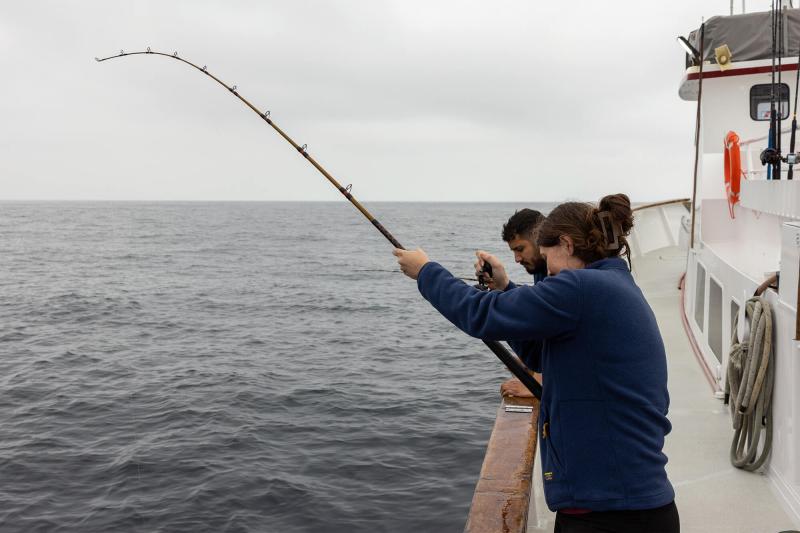The scientific knowledge of NOAA Fisheries and the on-the-water knowledge of anglers on the California coast have come together in a cooperative research program. It is filling in data gaps on the population and life cycle of rockfish. It started as a pilot project in 2022 with six charter boats in Southern California ports with a focus on quillback and copper rockfish. The program has expanded to 24 vessels this year, covering every recreational fishing port in the state. The results will inform management and help keep fishing within sustainable limits, which benefits ecosystems and anglers.
Rockfish are one of the most important and popular commercial and recreational fisheries in California. In recent years, management measures have been very effective at rebuilding previously overfished rockfish species, with 6 of the 7 stocks that were historically overfished being rebuilt over the past decade. However, recent estimates have shown numbers for some species have been in decline. NOAA Fisheries declared quillback rockfish off California overfished in December 2023 and can no longer be retained by recreational fishers. Copper rockfish dropped below target levels in the 2021 and 2023 stock assessments, prompting bag limits to be reduced to one per day for recreational anglers.
Charter Boats Get Involved
Alarmed by the status of her favorite fish and her future livelihood, Jamie Diamond looked to get involved. She wanted to help scientists and fishery managers collect data needed for a clearer view of rockfish populations. Diamond runs Stardust Sportfishing with her husband Jason in Santa Barbara. She’s also the Sportfishing Association of California’s Vice President for the Ventura and Santa Barbara County area. She’s also a new member of NOAA’s Marine Fisheries Advisory Committee.
Diamond’s two charter boats, the Stardust and the Coral Sea, fish off of the Channel Islands for calico bass, sand bass, halibut, and white seabass, and other species. But it’s rockfish that drive her business. “Rockfish is our number one,” she said. “If we don’t have rockfish, we don’t have much at all.”
Last year, her boats were among 22 charter operators that collected samples from San Diego north to Crescent City. They collected samples of 4,113 rockfish, including 34 species, from their clients’ hooks. Anglers got to take filets home for dinner, while the rest of each fish went to the Southwest Fisheries Science Center for dissection and analysis.
“We could not get these data without their help,” said Melissa Monk, a research scientist at the center’s Fisheries Ecology Division laboratory. She oversees this data collection project and conducts stock assessments; they go to the Pacific Fishery Management Council, which informs management by NOAA Fisheries. “More data means a more complete picture to support management,” she said.
Scientists at the lab extract their ear bones, called otoliths, which form layers the researchers can count like tree rings to estimate age. The scientists also determine the sex and maturity of the fish, and take fin clips to examine their genetics. The findings will support a new assessment of the species. It will have a more detailed picture of the growth of copper, quillback, and other rockfish and the ages of fish that recreational anglers catch.
Improved Data Supports Fishing Decisions
The effort capitalizes on the sportfishing fleet to collect more data and tissue samples on fish populations from those who know them best.
“We’re making the most of those early-morning and overnight fishing trips that are so important to the economy of coastal communities,” said Daniel Studt, Recreational Fishing Coordinator for NOAA Fisheries’ West Coast Region. “Catching fish provides data that helps us make better management decisions. That keeps fishing sustainable, which benefits us all.”
Researchers trained crew members on the sportfishing vessels to collect samples and designed protocols to avoid mistakes that could cloud the results. For example, the bags of fish caught by each angler are randomly assigned numbers. Crew members record samples from only the odd-numbered bags. That ensures more representative samples and avoids any risk of selecting bags with the most or biggest fish, which could skew the findings.
“Nobody wants to catch the last fish,” said Ken Franke, President of Sportfishing Association of California, who helped coordinate the participation of the charter vessels. The additional samples will inform stock assessments so that managers impose regulations appropriate for the species, and lift restrictions when the status of the species allows it. “Everybody wants robust fish populations and robust fisheries, and one thing that really helps us is good data to support the best science.”
Cooperative Research Strengthens Relationships
Commercial operators, as well as individual anglers, have welcomed the opportunity to help supply samples for research, Franke said.
They are also careful to release copper rockfish using descending devices, improving their odds of surviving after release. Some rockfish live at depths of several hundred feet or more. The pressure change of being reeled rapidly to the surface causes air within the rockfish to expand and can damage their internal organs. Descending devices help anglers return the fish to the depths they frequent near the sea floor, where they recover more easily.
Diamond said that the fleet hopes more complete data will provide a clearer picture of the species’ population structure. For instance, the assessment will analyze the ages and lengths of copper rockfish to understand the demographics of the population.
She said that anglers aboard the fishing vessels have been impressed by the collaboration and are eager to learn about fisheries science. With more than 60 species of rockfish in southern California waters, existing programs do not always collect adequate sample sizes for each one.
“We are trying to create a culture where we work together to support the science and the scientists recognize our role, too,” Diamond said. Anglers who contribute samples for research have greater confidence in the outcome, she said. “When they are participating, they feel a stake in it. They are going to listen to the scientists, and the scientists listen to them.”




